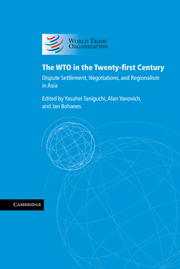Book contents
- Frontmatter
- Contents
- Notes on contributors
- Acknowledgements
- Table of dispute settlement cases and reports
- List of abbreviations
- Introduction
- PART I The WTO at Ten
- PART II Accomplishments and Future Prospects of the WTO Dispute Settlement System
- PART III Asian Perspectives on WTO Dispute Settlement
- PART IV The Doha Development Agenda and Beyond
- 16 The central place of market access for the WTO's development round
- 17 Agricultural issues in the Doha Development Agenda negotiations
- 18 Beyond Doha: reflections on the future of trade remedies
- 19 Reflections on the relationship between WTO negotiations and dispute settlement: lessons from the GATS
- 20 Trade in services and sustainable development in the context of the WTO: the case of higher education
- 21 The WTO and sustainable development
- PART V Asian Regional Integration and the Multilateral Trading System
- Index
19 - Reflections on the relationship between WTO negotiations and dispute settlement: lessons from the GATS
from PART IV - The Doha Development Agenda and Beyond
Published online by Cambridge University Press: 05 March 2012
- Frontmatter
- Contents
- Notes on contributors
- Acknowledgements
- Table of dispute settlement cases and reports
- List of abbreviations
- Introduction
- PART I The WTO at Ten
- PART II Accomplishments and Future Prospects of the WTO Dispute Settlement System
- PART III Asian Perspectives on WTO Dispute Settlement
- PART IV The Doha Development Agenda and Beyond
- 16 The central place of market access for the WTO's development round
- 17 Agricultural issues in the Doha Development Agenda negotiations
- 18 Beyond Doha: reflections on the future of trade remedies
- 19 Reflections on the relationship between WTO negotiations and dispute settlement: lessons from the GATS
- 20 Trade in services and sustainable development in the context of the WTO: the case of higher education
- 21 The WTO and sustainable development
- PART V Asian Regional Integration and the Multilateral Trading System
- Index
Summary
The General Agreement on Trade in Services (GATS) includes many unique features. One of these unique features is the ‘built-in agenda’ for new negotiations, which is set out in Article XIX. Even though successive rounds of tariff negotiations were held under the auspices of the General Agreement on Tariffs and Trade (GATT) 1947, the GATT Contracting Parties were never under any legal obligation to do so. In contrast, the GATS made it a legal obligation to conduct a new round of services negotiations. Specific mandates are given on the starting date of the negotiations (2000, or not later than five years from the date of entry into force of the Marrakesh Agreement Establishing the World Trade Organization (WTO Agreement); the aim of the negotiations (progressive liberalization ‘directed to the reduction or elimination of the adverse effects on trade in services of measures as a means of providing effective market access’); as well as the negotiating guidelines and procedures which shall be established by the Council for Trade in Services.
Pursuant to the built-in agenda, the new services negotiations started in early 2000. They encompass both rules (domestic regulation, safeguard, subsidies, etc.) and market access issues. According to the Guidelines and Procedures for the Negotiations on Trade in Services,1 the request-offer approach is the main method of negotiation of specific commitments. As of October 2005, the total number of initial offers submitted was 69 (representing 93 Members); with 54 initial offers remaining outstanding.
- Type
- Chapter
- Information
- The WTO in the Twenty-first CenturyDispute Settlement, Negotiations, and Regionalism in Asia, pp. 367 - 380Publisher: Cambridge University PressPrint publication year: 2007

